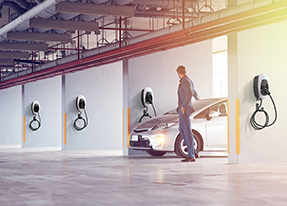Managing a transport revolution - electric vehicles in the built environment
Ross De Rango, Product Development Manager - Integration & Technology - NHP Electrical Engineering Products
2019 has been a record year for electric vehicles (EVs) globally, with EVs making up around 3% of total new passenger car sales in the world.
In China, new electric car sales are in the order of 1 million units per year and rising fast. This volume is already close to the total size of the Australian new car market and is set to surpass it in 2020. Australia has been relatively slow in taking up electric cars to date, but it’s coming.
The key benefits of shifting to EVs are clear. They are cheaper to run and maintain, they don’t contribute to local air pollution, they help to reduce dependence on oil imports, and they provide a pathway to a reduction in carbon emissions. The build out of infrastructure to support them will also create significant employment opportunities, particularly in the electrical sector.
Given the constraints of Australia’s existing electrical infrastructure design, for the EV revolution to happen we must manage how, where and when EVs are recharged, in order to avoid costly electrical upgrades. We also need to review a range of codes and standards that have a bearing on vehicle recharging, keeping in mind that there will not be a ‘one size fits all’ solution.
Australians are increasingly living in residential apartment complexes, where switchboards and electrical network connections are designed to accommodate existing peak demand. Such buildings will require some smart scheduling to make use of the spare overnight capacity to charge the EVs, without increasing the peak demand in the building.
In the inner-city suburbs of Australia, many residents park on the street because their homes don’t have driveways or garages. As the EV market grows, extension leads pulled across footpaths in these areas will become a problem, so we need to come up with better practices that work for everyone. Part of the answer here may be fast charging equipment in shopping precincts, which are starting to roll out in some suburbs already.
For the majority of Australians who live in houses with off street parking, the minimum necessary hardware for recharging an EV is already in place - the standard power point in the garage wall, which will comfortably deliver ~120km of added driving range overnight. While recharging will be convenient for these residents, they will largely be doing so at the same time as millions of others – when they get home from work in the afternoon and then walk inside to turn on the air-conditioning. The electricity grid will not cope with the increase in peak demand on hot summer days, so work needs to be done to ensure that EV drivers are appropriately incentivised to avoid contributing to peak demand in this way.
Away from home on long trips, drivers of pure battery electric vehicles (BEVs) will use fast chargers spread along our regional routes. Various organisations started deploying these around Australia several years ago, and the number of active sites is rapidly increasing. These sites can be found on Plugshare, where the map is starting to look very similar to a map of petrol stations around the country.
Drivers of Plug-In Hybrid EVs (PHEVs) will generally use electricity for their day-to-day driving, drawn either at work or at home, and petrol for the longer trips. For example, my recent family holiday included Echuca, Balranald and Lake Mungo National Park. There’s not much infrastructure of any kind around Lake Mungo – no bitumen, petrol stations, power lines, or phone coverage - but the ability to use a combination of electricity and petrol to fuel the vehicle made it easy. We even rescued a couple stranded with a broken-down car along the way! It can be expected that many Australians will opt for this style of vehicle while the build-out of fast charging sites occurs, and pure battery EVs fall in price.
Securing good outcomes at scale as electric vehicles roll out will be a big challenge and will require plenty of collaboration. We’re looking at a multi-decade shift from using billions of litres of petrol each year, to using billions of kilowatt-hours of electrical energy. The infrastructure implications will be enormous and some changes to various codes, standards, and regulations will be required. By working together, we can ensure these changes secure the best outcomes for our country.
